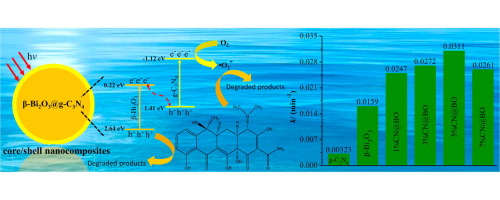Chemical Engineering Journal ( IF 13.3 ) Pub Date : 2018-01-04 , DOI: 10.1016/j.cej.2017.12.108 Yuanzhi Hong , Changsheng Li , Bingxin Yin , Di Li , Zhengyuan Zhang , Baodong Mao , Weiqiang Fan , Wei Gu , Weidong Shi

|
The elimination of recalcitrant pollutants from wastewater using core/shell structure photocatalysts has received much attention in the area of environmental science. In this study, novel β-Bi2O3@g-C3N4 core/shell nanocomposites were firstly fabricated via a feasible self-assembly methodology, in which β-Bi2O3 nanoparticles were chosen as the host material for g-C3N4 loading. The photocatalytic activity of the samples were evaluated by the degradation of antibiotic tetracycline (TC) under visible-light illumination (λ > 420 nm). Compared to the pristine β-Bi2O3 and g-C3N4, the prepared core/shell nanocomposites showed remarkably enhanced photocatalytic performance towards TC degradation in aqueous solution. Eventually, the 5 wt% g-C3N4 loaded core/shell sample (5%[email protected]) exhibited the optimum photocatalytic efficiency, and its rate constant (k = 0.0311 min−1) for TC degradation is much higher than lots of the previously reported photocatalysts. In addition, the as-synthesized 5%[email protected] also displayed excellent photostability for degradation of TC even after 5 times recycling tests. The highly visible-light-induced photoreactivity is ascribed to the formation of a core/shell Z-scheme heterojunction, which could significantly accelerate the separation of photoinduced electron-hole pairs and prolong the lifetime of charge carriers. This work provides an efficient core/shell nanomaterial for removal of antibiotic pollutants and will be useful for design of other core/shell photocatalysts.
中文翻译:

通过一个有效和稳定促进四环素的可见光诱导的光催化降解的β-Bi系2 ö 3 @gC 3 Ñ 4核/壳纳米复合材料
使用核/壳结构光催化剂消除废水中的顽固污染物已在环境科学领域引起了广泛关注。在这项研究中,新颖的β-Bi系2 ö 3 @gC 3 Ñ 4核/壳纳米复合材料通过一种可行的自组装方法,首先制成,其中β-Bi系的2个ö 3纳米颗粒被选为用于GC基质材料3 Ñ 4加载。通过在可见光(λ> 420 nm)下抗生素四环素(TC)的降解来评估样品的光催化活性。相较于原始β碧2 Ø 3和GC3 N 4,制备的核/壳纳米复合材料对水溶液中TC降解表现出显着增强的光催化性能。最终,载有5 wt%gC 3 N 4的核/壳样品(5%[有电子邮件保护])表现出最佳的光催化效率及其速率常数(k = 0.0311 min -1)对TC的降解远高于许多以前报道的光催化剂。此外,即使经过5次循环测试,合成后的5%(受电子邮件保护)也显示出出色的光稳定性,可降解TC。高度可见光诱导的光反应性归因于核/壳Z方案异质结的形成,这可以显着加速光致电子-空穴对的分离并延长电荷载流子的寿命。这项工作为去除抗生素污染物提供了一种有效的核/壳纳米材料,将对设计其他核/壳光催化剂有用。










































 京公网安备 11010802027423号
京公网安备 11010802027423号